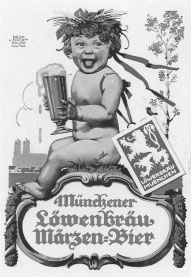Löwenbräu is one of the world’s oldest and most iconic beer brands. The Löwenbräu brewery is located in Munich and dates back to 1383. Löwenbräu means “lion’s brew” in English and its logo is an easily identifiable crest depicting a standing, tongue-flicking lion with a twisted double tail. The name derives from the original brewpub known as Löwengrube (Lion’s Den) at house number 17 on a street of that same name. The first documented mention of brewing at the Löwengrube is in the name of Jörg Schnaitter in a Munich tax record of 1524, where Jörg is identified as a “pierprew,” which is old German for a beer brewer. Löwenbräu as the name of the brewery at the Lion’s Den appears on record for the first time in a Munich brewer registry in 1746. In 1818 a brewer named Georg Brey purchased the Löwenbräu and embarked on an expansion strategy, acquiring additional brew sites and adding bockbier to his portfolio in 1848. By the brew season 1863/1864, Löwenbräu supplied about one-quarter of the entire Munich beer market, which made it Munich’s largest brewery.

Löwenbräu means “lion’s brew” in English, a name derived from the brewery’s original location, the late 14th-century Löwengrube (Lion’s Den) brewpub in Munich. The brewery’s logo hangs from the shoulder of a cherub in this 1920 postcard. pike microbrewery museum, seattle, wa
By 1872, the brewery became a stockholder’s company, and a year later, the still famous Löwenbräukeller opened. By 1912, the Löwenbräu annual output reached almost 1 million hl (852,168 US bbl), but it declined by the end of World War I to just about half that volume. A merger with Unionsbrauerei Schülein & Cie., in 1921, however, marked the return of growth. The brewery added a weissbier to its portfolio in 1927 and, a year later, even surpassed its prewar volume. Löwenbräu surpassed the 1.5 million hl (1.2 million US bbl) mark in the 1970/1971 brewing season.
Exports, too, become an even more important factor in the Löwenbräu business strategy. In 1974, Löwenbräu arrived in the United States by way of a contract arrangement with the Miller Brewing Company in 1974. The beer marketed under the Löwenbräu name, however, was very different from the all-malt, Reinheitsgebot-guided original.
Anheuser-Busch InBev history. http://www.lowenbrau.com.au/. Gaab, Jeffrey S. Munich: Hofbräuhaus & history—Beer, culture, & politics. New York: Peter Lang Publishing, Inc., 2006.
